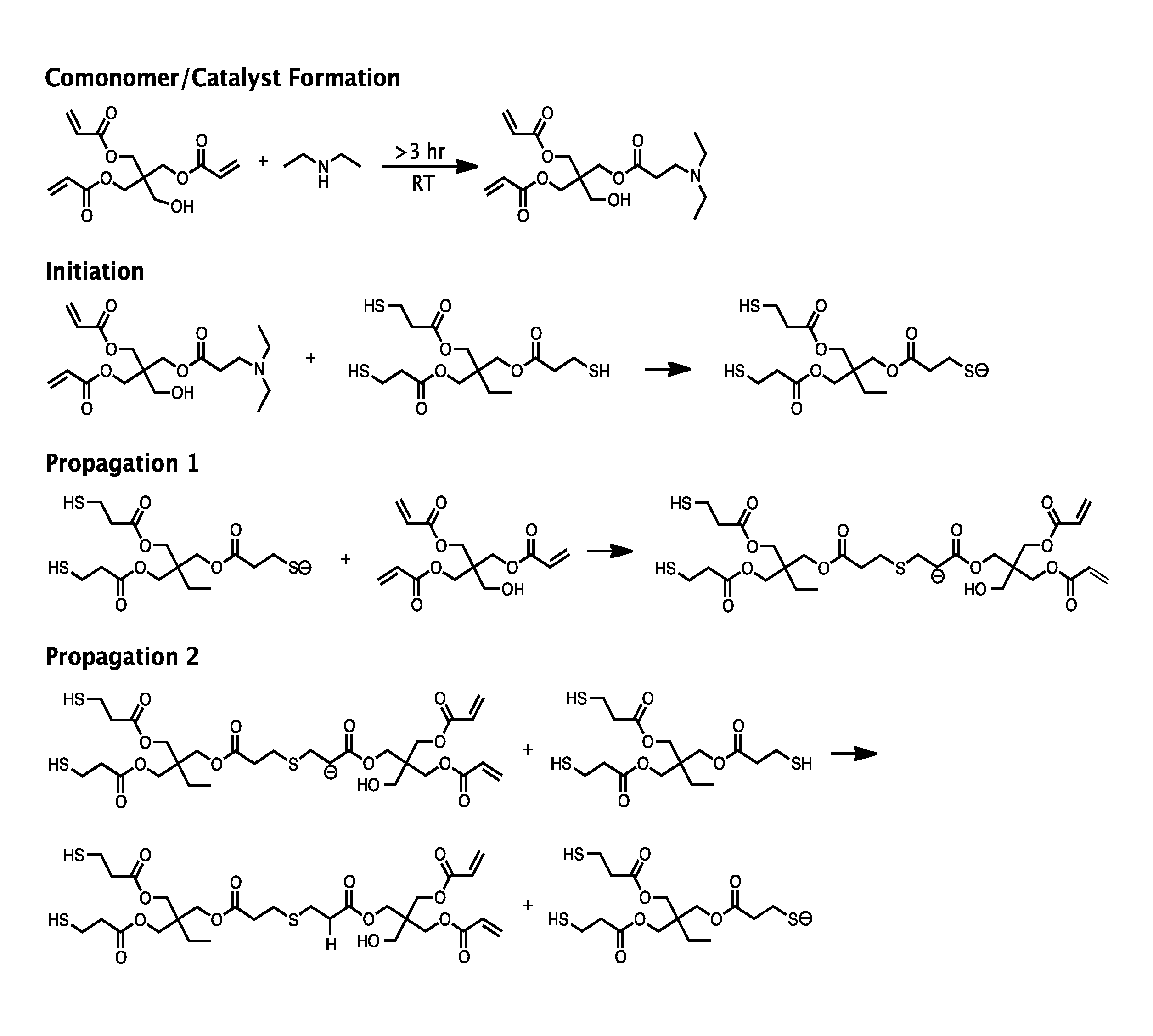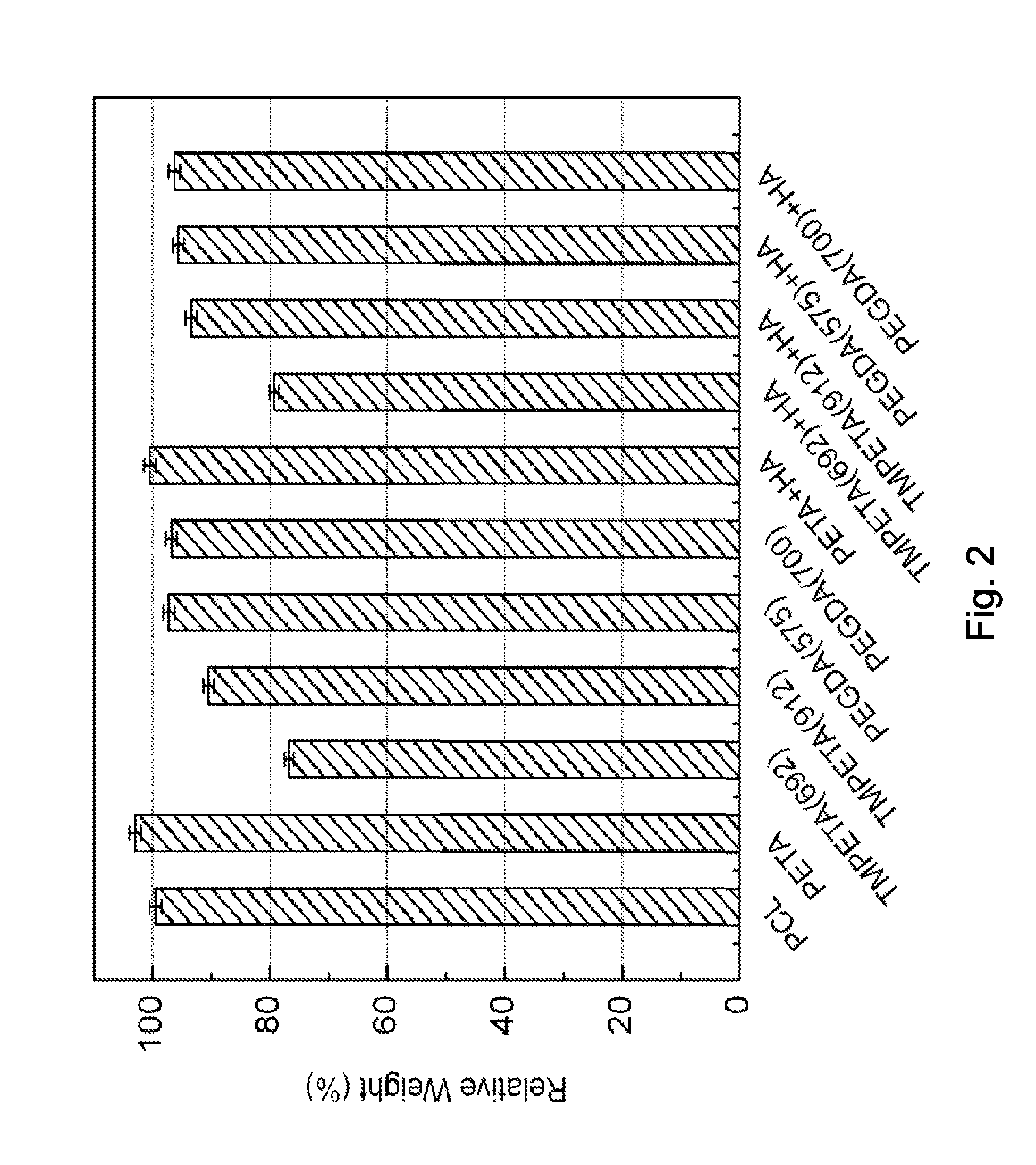Thiol Acrylate Nanocomposite Foams
a technology of thiol acrylate and nanocomposite foam, which is applied in the direction of biocide, drug composition, prosthesis, etc., can solve the problems of high potential for disease transmission, limited quantity, and high cost of allogeneic bone grafts, and achieve rapid co-polymerization
- Summary
- Abstract
- Description
- Claims
- Application Information
AI Technical Summary
Benefits of technology
Problems solved by technology
Method used
Image
Examples
example 1
Materials
[0041]Unless otherwise stated, the stromal control media used in the prototype demonstrations comprised Dulbecco's Modified Eagle's Medium, 10% fetal bovine serum, and 1% triple antibiotic solution. Unless otherwise stated, the osteogenic media used in the prototype demonstrations comprised Dulbecco's Modified Eagle Medium, 10% fetal bovine serum, 1% triple antibiotic solution, 0.1 μM dexamethasone, 50 μM ascorbate-2-phosphate, and 10 mM β-glycerophosphate.
[0042]All reagents were used as received.
MaterialAbbreviationNoteSupplierpoly(ethylene glycol) diacrylatePEGDAMW 700 andAldrichMW 575trimethylolpropane ethoxylate triacrylateTMPETAMW 912 andAldrichMW 692trimethylolpropane triacrylateTMPTAAldrichpoly-ε-caprolactonePCLAldrichtrimethylolpropane tris(3-mercaptopropianate)TMPTMPAldrichpentaerythritol triacrylatePETAAlfa AesardiethylamineDEA99% purityAGROS Organicshydroxyapatite crystalsHAhuman adipose-derived stromal cellshASCStromal control media: Dulbecco's ModifiedEagle's M...
example 2
Preparation of Thiol-Acrylate Compositions
[0043]Several compositions containing TMPTMP with di- or tri-functional acrylates (listed in Example 1) were prepared in a 1:1 functionality ratio. These compositions were subjected to mass loss and hASC cytotoxicity tests (explained in Examples 4 and 5). Twenty stock solutions containing PETA, a preferred acrylate in terms of biocompatibility and mass loss data, and DEA (content ranging from 2.8-35.1%) were prepared, and the resulting copolymer compositions were subjected to mechanical testing (Example 6).
[0044]The strength of the materials can be altered by varying the initial DEA concentration. The functionality and thus the cross-linking density are functions of the amine concentration. The first Michael addition reaction with the secondary amine results in a loss of one acrylate functionality from the trifunctional acrylate.
[0045]A 16.1% DEA concentration was chosen for use in a preferred bone repair composition because it produced the ...
example 3
Preparation of Foamed and Solid Materials
[0046]DEA and PETA were used to prepare a solution for both foamed and solid composite materials. The DEA and PETA (16.1% DEA by acrylate molar functionality) were combined in advance, and stirred for 24 hours to form the in situ catalyst / comonomer. TMPTMP was added in a 1:1 molar functionality ratio (i.e., the ratio of thiol groups to acrylate groups), and the material was mixed with a stir rod for 3 hours. Then several concentrations of HA (0%, 15%, 20%, 25% wt / wt) were added to the PETA-co-TMPTMP solution. This solution was cast into cylindrical molds (10×10 mm), and allowed to cure for 24 hours to form the solid composite copolymer material.
[0047]A foamed composite copolymer was prepared by pouring the PETA-co-TMPTMP with HA (0%, 15%, 20%, 25% wt / Wt) into a 250 mL pressurized spray canister using 7 g compressed nitrous oxide as a gas foaming agent. The mixture was expelled from the canister into the same types of cylindrical, polydimethyl...
PUM
| Property | Measurement | Unit |
|---|---|---|
| pore size | aaaaa | aaaaa |
| emission wavelength | aaaaa | aaaaa |
| excitation wavelength | aaaaa | aaaaa |
Abstract
Description
Claims
Application Information
 Login to View More
Login to View More - R&D
- Intellectual Property
- Life Sciences
- Materials
- Tech Scout
- Unparalleled Data Quality
- Higher Quality Content
- 60% Fewer Hallucinations
Browse by: Latest US Patents, China's latest patents, Technical Efficacy Thesaurus, Application Domain, Technology Topic, Popular Technical Reports.
© 2025 PatSnap. All rights reserved.Legal|Privacy policy|Modern Slavery Act Transparency Statement|Sitemap|About US| Contact US: help@patsnap.com



